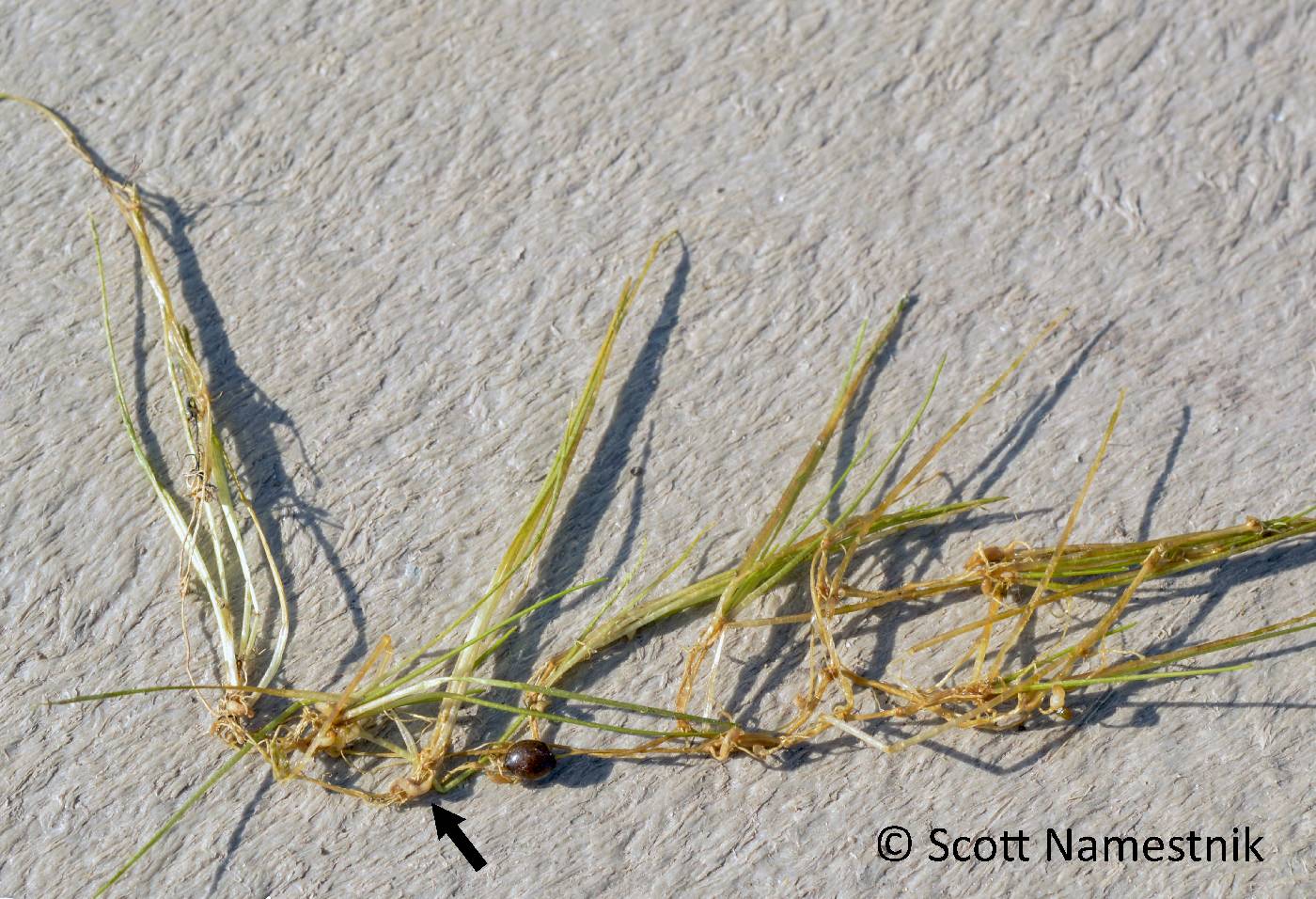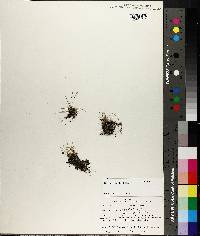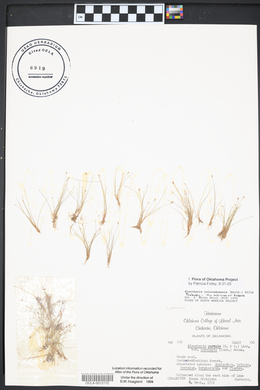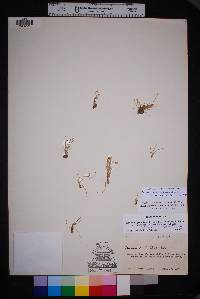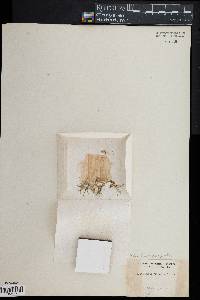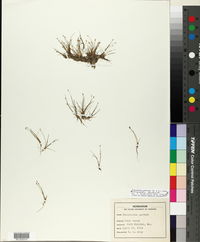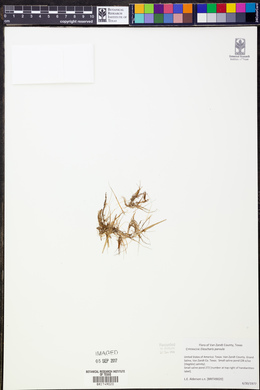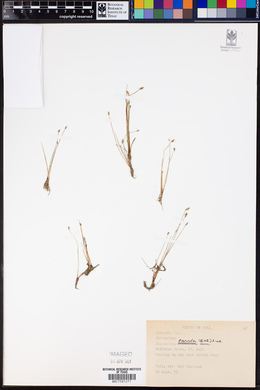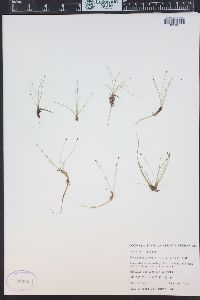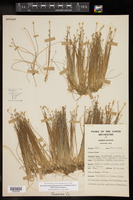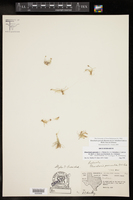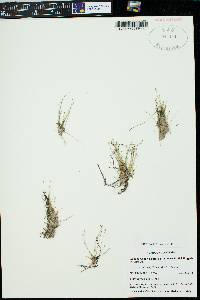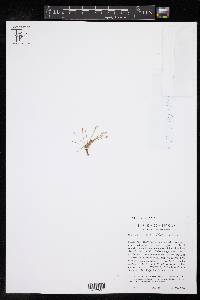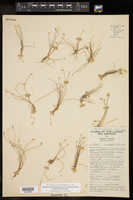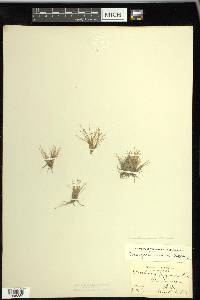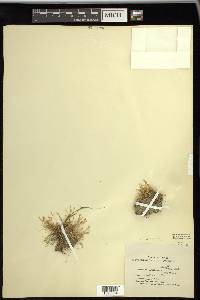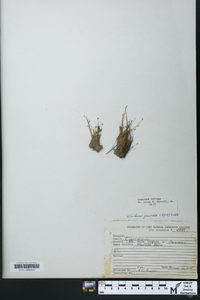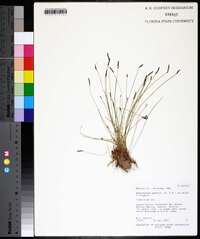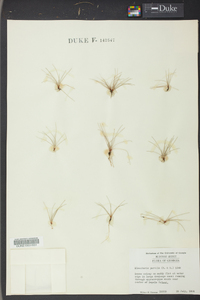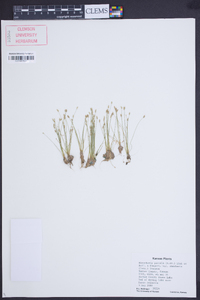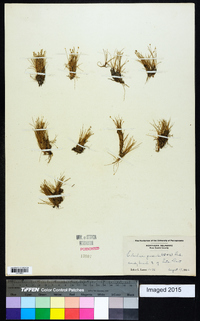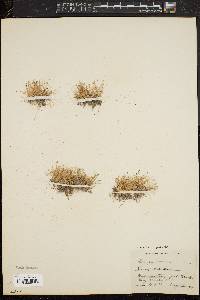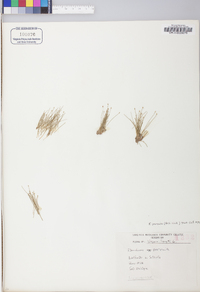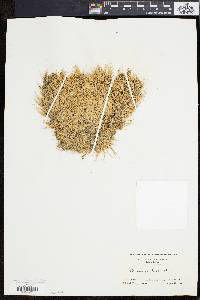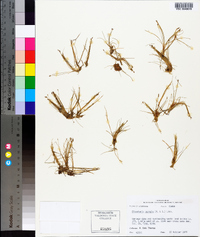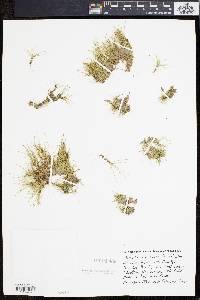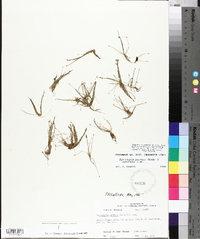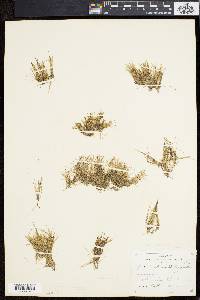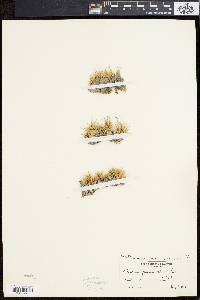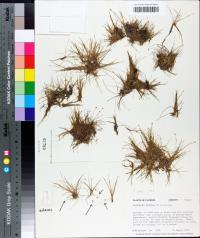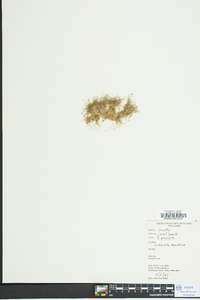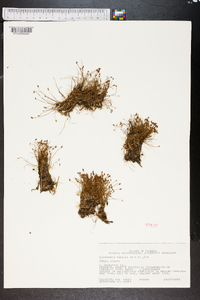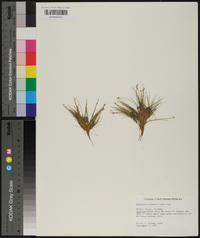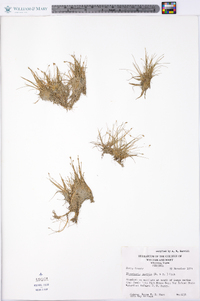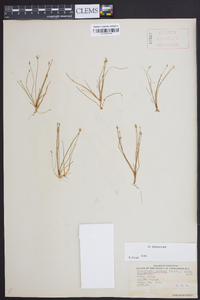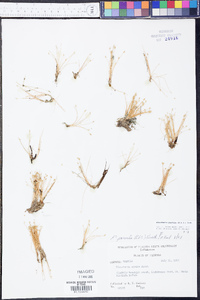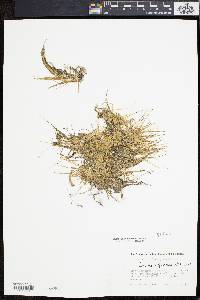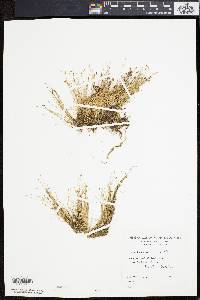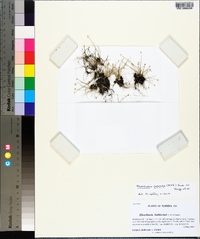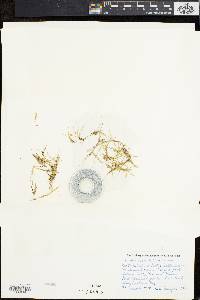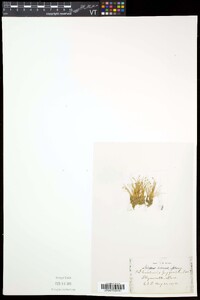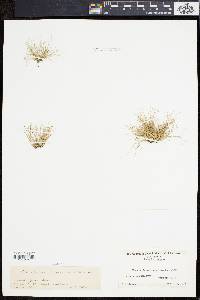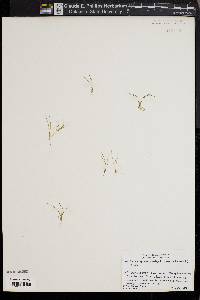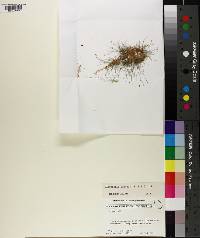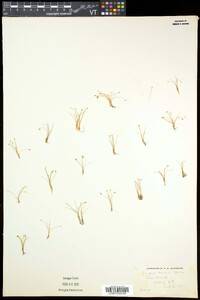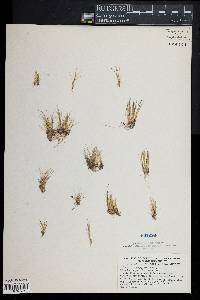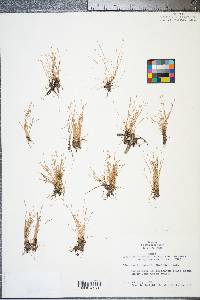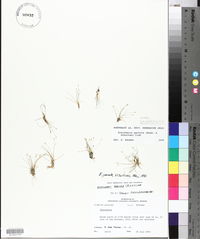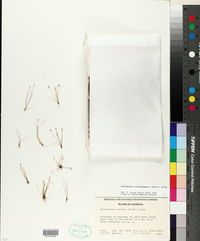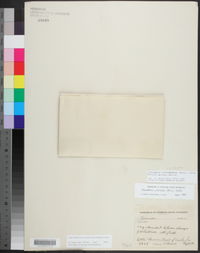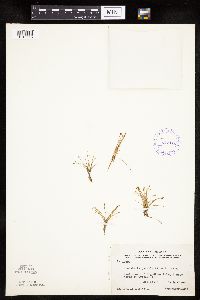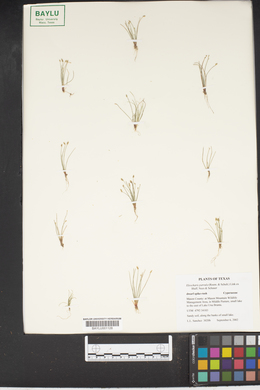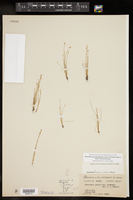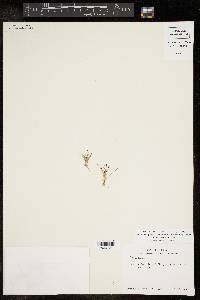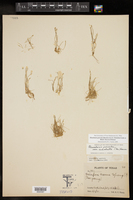
|
|
|
|
Family: Cyperaceae
dwarf spikerush, more...Little-Head Spike-Rush, dwarf spikesedge, little-head spikerush
[Chaetocyperus membranacea, moreChaetocyperus membranaceus Buckley, Eleocharis leptos (Steud.) Svens., Eleocharis leptos var. coloradoensis (Britt.) Svens., Eleocharis leptos var. johnstonii Svens., Eleocharis membranacea Gilly, Eleocharis parvula f. spongiosa Fassett, Eleocharis parvula var. coloradoensis (Britt.) Beetle, Scirpus nanus var. anachaetus Britton, Scirpus parvulus] |
Tubers terminating rhizomes usually markedly J- or horseshoe-shaped, body (apart from apical bud) oblong, 2-2.5(-5) × 0.5-1 mm; tubers among culm bases straight, narrowly fusiform, 4-5 mm. Spikelets 2-4 × 1-2 mm, sometimes absent in deeper water; proximal scale 1/2 or more of spikelet length; floral scales 6-10 per spikelet, 1.4-2.7 mm, commonly entirely stramineous, apex rounded to subacute. Flowers: perianth bristles 6, stramineous, fairly stout to slender, usually equaling achene to slightly exceeding tubercle, sometimes unequal and some 1/2 of achene, very rarely rudimentary, minutely retrorsely spinulose; anthers 0.7-1.2 mm. Achenes stramineous, sometimes pale brown, obovoid to obpyriform, thickly trigonous, angles distinct, faces concave to plane, rarely convex, 0.9-1.2 × 0.55-0.75 mm, apex tapered, smooth or faintly rough at 30X. Tubercles 0.1-0.2 × 0.15 mm. 2n = 10 (Europe). Fruiting summer-fall (north) or late winter-fall (far south). Brackish or saline, mostly coastal tidal marshes, shores, mud flats, swamps, ponds, ditches; 0-600 m; B.C., N.B., Nfld. and Labr., N.S., Que.; Ala., Ark., Calif., Conn., Fla., Ga., Ill., Ind., Kans., La., Maine, Md., Mass., Mich., Miss., Mo., N.J., N.Y., N.C., Ohio, Oreg., S.C., Va., Wash.; Mexico; Central America (Nicaragua); Eurasia. Plants without well-developed bristles are otherwise typical Eleocharis parvula. S.-O. Strandhede and R. M. T. Dahlgren (1968) provided a detailed description from Scandinavia; the mostly curved tubers of North American plants are differently shaped than the ovoid, mostly nearly straight tubers illustrated by them. Eleocharis parvula is very uncommon inland. Plants lacking spikelets and having rather broad culms with evident aerenchyma (E. parvula forma spongiosa Fassett) that are submerged in tidal zones closely resemble small plants of Sagittaria graminea. Eleocharis parvula has also been reported from North Dakota, South America, and Africa; I have not seen specimens. Plants without achenes or tubers cannot be reliably identified to species. Literature reports from Cuba, Mexico, and Venezuela may be based on specimens of E. coloradoensis.
FNA 2003, Cronquist et al. 1977 Common Name: dwarf spikerush Duration: Perennial Nativity: Native Lifeform: Graminoid General: Diminutive plant with slender form from inconspicuous rhizomes, usually forming dense mats, 2-6 cm tall. Vegetative: The stems are filiform. Inflorescence: The terminal spikelet is 2.5-4 mm long with 2-9 flowers, the scales 1.5-2 mm long, the lowest one empty, the achenes are stramineous to pale brown, obovoid to obopyriform to three sided, about 1 mm. Ecology: Found in wet soil, creekside, saline sites, brackish water from 4,000-6,000 ft (1219-1829 m), flowers summer and fall. Notes: The minute size is key among the Eleocharis, but can be confused with small specimens of other Eleocharis. To distinguish from Bulbostylis pay attention to the multiple spikelets emerging from one tiny set of roots, not the single stem found in Eleocharis emerging from a very tiny rhizome. Ethnobotany: Unknown Etymology: Eleocharis is from Greek heleos or helos, a marsh, low ground, meadow and charis, grace, beauty, hence marsh grace, while parvula means dwarf or small. Synonyms: E. coloradoensis, E. leptos, E. leptos var. coloradoensis, E. leptos var. johnstonii, E. membranacea, E. parvula var. anachaeta, E. parvula var. coloradoensis Editor: SBuckley, 2011 Diminutive, very slender perennial from inconspicuous slender rhizomes, forming dense mats; stems filiform, 2-6(-10) cm; spikelet ovoid, 2.5-4(-6) mm, with 2-9(-20) fls; scales ovate, obtuse or acute, green to stramineous or brown, 1.5-2(-2.5) mm, the lowest one empty; style trifid; achene stramineous, ±trigonous, 0.9-1.3 mm including the short (0.15-0.3 mm), thickened, confluent tubercle; 2n=8, 10. Wet, saline or alkaline sites; irregularly cosmop. The var. parvula, with bristles equaling or surpassing the smooth achene, occurs in salt-marshes on both coasts of N. Amer. and at scattered inland stations chiefly e. of the Mississippi R., as well as in the Old World. The var. anachaeta (Torr.) Svenson, with the bristles ±reduced or obsolete, and often with cellular-roughened achenes, occurs at scattered inland stations w. of the Mississippi, s. to Mex. and the Caribbean. (E. coloradoensis) Gleason, Henry A. & Cronquist, Arthur J. 1991. Manual of vascular plants of northeastern United States and adjacent Canada. lxxv + 910 pp. ©The New York Botanical Garden. All rights reserved. Used by permission. From Flora of Indiana (1940) by Charles C. Deam Indiana Coefficient of Conservatism: C = 10 Wetland Indicator Status: OBL |
This project was made possible in part by the Institute of Museum and Library Services [MG-70-19-0057-19].
Powered by Symbiota

